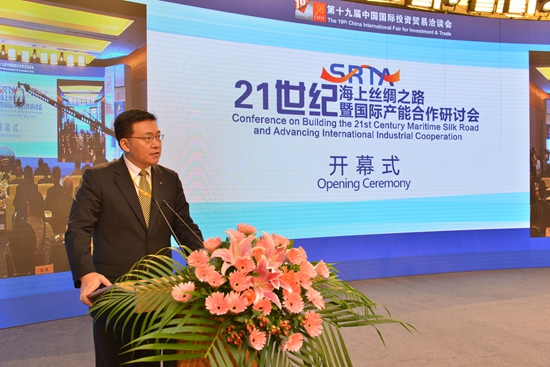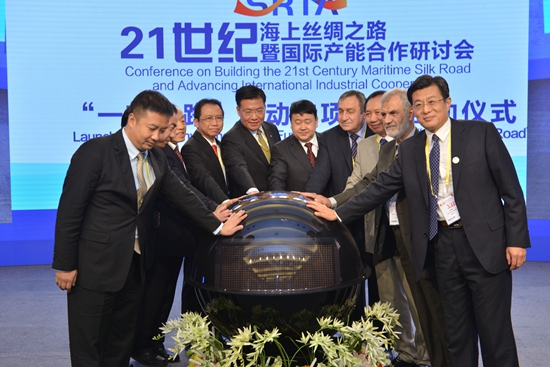Maritime Silk Road conference inspires cooperation
 0 Comment(s)
0 Comment(s) Print
Print E-mail China.org.cn, September 28, 2016
E-mail China.org.cn, September 28, 2016
|
|
|
Vice Minister Guo Yezhou of the International Department of the CPC Central Committee delivers a speech at the opening ceremony of the Maritime Silk Road conference, Sept. 7, 2016. |
More than 200 world dignitaries, officials, think-tank representatives and entrepreneurs gathered in Xiamen, southeast China's Fujian Province, to explore the development and future of the China-initiated 21st Century Maritime Silk Road (MSR) in September.
They were in Xiamen to attend the Conference on Building the 21st Century Maritime Silk Road and Advancing International Industrial Cooperation.
To promote MSR development, countries concerned should enhance efforts to optimize their trade structure, strengthen coordination and connectivity based on ocean economy, create innovative multi-level financing vehicles like the Asian Infrastructure Investment Bank (AIIB), build land and maritime transportation networks and boost people-to-people exchange, urged Guo Yezhou, vice minister of the International Department of the Central Committee of the Communist Party of China (CPC) and chairman of the council of China Center for Contemporary World Studies (CCCWS), at the conference.
As a country with advantages in the equipment manufacturing industry, China is willing to serve the needs of countries along the road and beef up related cooperation, said Guo.
Participants at the conference agreed that the "Belt and Road" initiative should not be a solo effort; Wei Jianguo, former Chinese vice minister of commerce, said the "Belt and Road" initiative welcomes involvement not only from countries along the road but also from other countries including trans-national groups, think tanks and finance organizations like the International Monetary Fund and the Asian Development Bank.
In 2013, Chinese President Xi Jinping proposed building a close-knit China-ASEAN community and offered guidance on constructing a 21st Century Maritime Silk Road to promote maritime cooperation. It was designed to go from China's coast to Europe through the South China Sea and the Indian Ocean along one route, and from China's coast through the South China Sea to the South Pacific along another.
In addition, the "Belt and Road" initiative is not just about "hard cooperation" like infrastructure; it also contains soft elements like culture and people-to-people contact, said Essam Sharaf, former prime minister of Egypt, at the conference.
The "Belt and Road" initiative, a golden opportunity for all, will help to promote understanding and friendship among the people of the countries around this road through people to people, business to business and government to government cooperation in the areas of culture, education, science, technology and social welfare and sport, said Sharaf.
To move the MSR forward, Sharaf highlighted the need for improvement in maritime transportation through the Maritime Silk Road, the driving force of hidden potential economic capabilities.
|
|
|
On the sidelines of the conference, the Special Fund for the Activities of the "Belt and Road" was launched in Xiamen, Sept. 7, 2016. |
On the sidelines of the conference, the Special Fund for the Activities of the "Belt and Road" was launched in Xiamen by the China Friendship Foundation for Peace and Development with an aim to beef up agricultural and industrial cooperation and boost exchanges for countries along the Silk Road.
The conference was jointly sponsored by the Belt and Road Think Tank Association, the China International Fair for Investment and Trade Organizing Committee and the Eco-Agriculture and Food Safety Forum for the Belt and Road. It was co-hosted by Fudan University and Huaqiao University and organized by the China Center for Contemporary World Studies and the Foreign Affairs Office of the Fujian Provincial Government.








Go to Forum >>0 Comment(s)